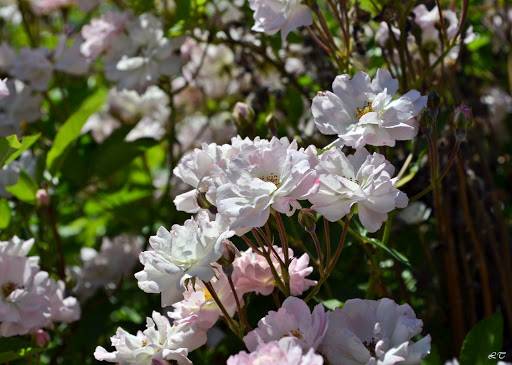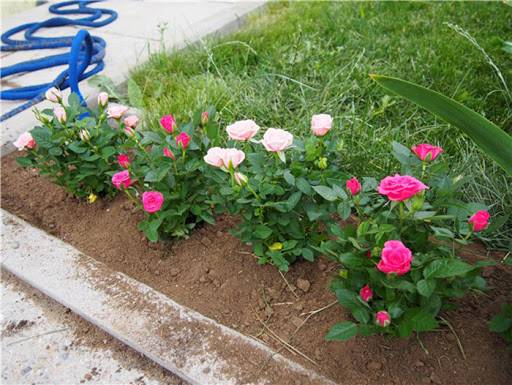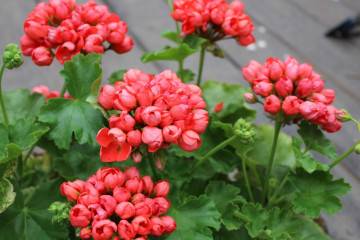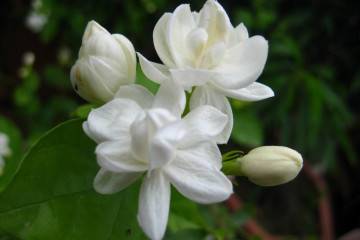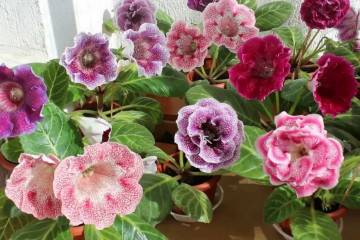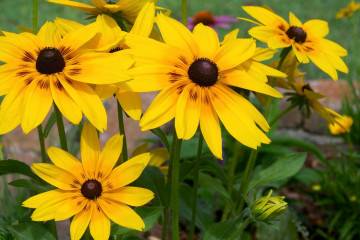Small garden roses - popular varieties
Content:
Shrub roses traditionally decorate gardens, the variety of varieties allows you to combine several varieties on the site. If its area is small, you should pay attention to dwarf roses. For the most part, they are miniature copies of common varieties. But their care has its own characteristics, like planting, reproduction and pest control.
Dwarf roses: description
The homeland of dwarf roses is China, from where they came to Europe in the early 19th century, where they failed to gain popularity. Then large varieties were widespread, they did not pay attention to small roses. A revolution in European history of short roses took place in 1918 thanks to a Swiss grower. He brought the Bengal rose from China to Switzerland and then to Bulgaria. This variety was later named in his honor - Rosa Rouletti, he became the first of a group of low-growing varieties of roses.
Mini-roses have a small bush height from 15 to 55 cm, on average 40 cm.The buds are located singly or in inflorescences, their diameter reaches 3-5 cm.They rarely exude a strong aroma, only a weak fragrance or its complete absence. This property will allow you to grow small bushes for allergy sufferers, as well as plant them next to strong-smelling flowers, dwarf roses will not kill the aroma.
Outdoor miniature roses are not the only way to use them in landscape design. They look great in pots, they can be used to decorate gazebos and arches. Also, mini-roses can twine around columns or become a hedge, a backdrop for other non-flowering plants. The combination of bushes of different varieties, contrasting colors with white, for example, looks interesting. Their resistance to frost and soil quality makes them an excellent alternative to regular roses.
The best varieties of miniature roses for growing in the garden and at home
There are several dozen varieties of flowers of small roses, they are classified according to the same characteristics as ordinary roses. Knowing the features of the variety you like will determine whether it is suitable for specific growing conditions.
Orange Jewel
This dwarf variety is intended for pot cultivation. It is compact, its height reaches no more than 30 cm. It grows rapidly and has large, densely double buds of a beautiful salmon-orange color.
Clementine
This dwarf garden rose is known for its flower buds. During the flowering period, it changes from pink to peach.
The size of Clementine's buds is large for flowers of small roses, up to 5 cm. It belongs to perennial plants, it is easy to care for it.
Baby Baccarà
Despite the small height of the bush, only 25 cm, these pink little bushes look like smaller copies of roses in the traditional representation.The classic-shaped buds have a rich burgundy hue, and the dense leaves are cast in bronze.
Hummingbird (Colibri)
An unpretentious frost-resistant variety, which was bred in the middle of the 20th century. The height of the bushes is up to 25 cm, the flowers are medium-sized and grow in inflorescences on the branches. The buds have a bright yellow-orange color.
Lavender
Small roses can look majestic, and the Lavender variety is a vivid confirmation of this. Bushes up to 50 cm high are covered with large buds, 1-3 flowers grow on one stem. They deserve the right to be called so, the color of their petals has a delicate lavender shade of lilac.
Daniela
An interesting French variety of a dwarf rose was bred in the 90s. last century. It is distinguished by its small size (only 20 cm in height) and rosette-shaped buds with a pink gradient along the edging of the petals. It blooms profusely, is afraid of frost, but well resists diseases and pests.
Amulet
These small roses grow up to 50 cm, have very dense foliage and bright pink buds. Young bushes are resistant, quickly grow foliage and have abundant flowering.
Landing
Planting and caring for mini roses in the garden begins with choosing the right place. You need to find an elevated site on the southeast side. The soil should be loose, without accumulation of melt and rainwater. The choice of the side is also not accidental: in the early morning the sun will dry the dew, and the sun's rays in the afternoon will not burn the delicate petals.
Step-by-step landing instructions:
- Dig a hole so that its dimensions are 10 cm larger than the earthen lump of the seedling. Loosen the bottom, if necessary, lay drainage material.
- Plant the rose with a graft 5 cm below ground level, carefully deepen. Cover with earth mixed with compost in a ratio of 1: 3, add a handful of ash.
- In order to plant the bush evenly, the earth should be poured gradually, holding the bush with your hand.
- Compact the soil after planting.
- Mark the boundaries for watering so that the water does not spread. A diameter of 15 cm is enough.
Miniature roses in the open field quickly take root if planting correctly. If damaged shoots are found in front of her at the bush, they must be removed.
Mini roses at home
Planting young bushes in a pot is carried out at the same time as for a dwarf garden rose. The side is also east, and the pot should be large. The soil must be mixed from 2 parts of turf, 2 parts of humus and 0.5 parts of sand. The composition must be poured with boiling water, steamed, and only after that you can start planting:
- Lay expanded clay or other drainage at the bottom of the pot.
- Fill 1/3 of the volume with potting soil.
- Pour it so that water flows from the holes at the bottom.
- Place the rose bush in a pot, cover with earth so that 2-3 cm remains to the brim.
- Compact the soil a little.
After that, the rose can be taken out on the windowsill, now the bush should take root. Watering roses is carried out 1-2 times a week as the topsoil dries out. Moistening should be exactly the roots, that is, abundant and to the full depth. The best time to water is before 10:00 or in the evening before sunset. The water should be settled, without impurities.
Feeding flowers of small roses is carried out after each flowering wave. In the spring, they need nitrogen, phosphorus and potassium.In preparation for winter, fertilization must be stopped so that intense flowering or foliage does not start.
Caring for a rose in the garden
Caring for miniature roses is easier than for ordinary ones, they are more unpretentious and less prone to disease. Even a novice gardener can cope with them if he follows simple rules:
- watering. While the rose bush takes root, it is watered almost every day, then, as the earthen coma dries, about 1-2 times a week. Watered under the root with warm, settled water, it is advisable not to spray on the leaves and buds;
- top dressing. The rose needs nutrition in the spring and during the flowering period. We need nitrogenous, phosphorus and potash fertilizers. In late autumn, feeding is stopped;
- pruning. Remove damaged shoots before planting. Also, pruning is carried out immediately after planting, leaving 3 buds on the stem (this forms a bush). During the flowering period, wilted buds are removed, shortening the stem by 4 cm. Before the winter months, diseased shoots are removed and healthy ones are shortened;
- for the winter, pruning is carried out, feeding with nitrogen fertilizers is stopped and watering is reduced. In the first frosts, they spud the bush, and with the onset of frost they cover it with spruce branches or other material.
Reproduction of roses is carried out by cuttings, this procedure is no different for dwarf roses.
Pests and diseases
Most varieties of mini roses are disease resistant, most often they are affected by black spot and rust. Damaged shoots must be removed, and the bush itself must be treated with a fungicidal preparation.
Pests that dwarf varieties are susceptible to are aphids, spider mites and thrips. Spraying with a 3% solution of copper sulfate, as well as a soap solution, helps well from them. Insecticidal preparations can also be used. In order to detect a lesion in time, the bushes need to be inspected at least once a week.
Miniature roses are not inferior in beauty to ordinary ones, sometimes their flowering is even more spectacular, and the buds are brighter. They have a lot of varieties, they can grow in pots or open ground, such roses are also used to create boutonnieres. The rules for planting and caring for them are not complicated, they can easily transform even a small garden.
